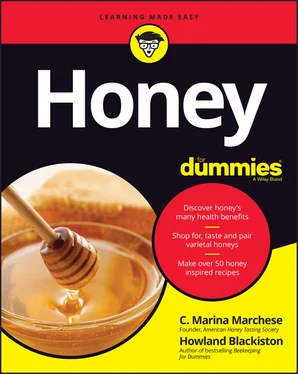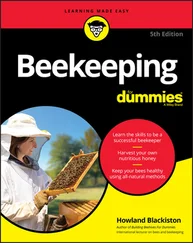Next, honey is hygroscopic, meaning that when it is openly exposed to moisture or humid conditions, it will absorb water. This is because honey is a supersaturated solution and honey bees are able to dissolve much more sugar in water than normal using heat. This hygroscopic behavior comes in handy when honey comes in contact with bacteria. Honey will absorb any moisture surrounding bacteria, which will dehydrate and kill the cell. So be sure to put the lid back on your honey jar, especially when it is humid.
The last amazing thing that honey bees do is add their own enzymes to honey, and one in particular, called glucose oxidase, is added during the ripening process. Glucose oxidase prevents the honey from fermenting and is what breaks down the glucose sugar in honey to gluconic acid. This action produces hydrogen peroxide and is another major factor in why honey is said to have antibacterial properties. Hydrogen peroxide occurs in small quantities for a short time, and this happens only when the honey has not been heat treated and is in the presence of water. The pH of hydrogen peroxide is 6.2 (ideal for contact with blood and tissue), so consuming a spoonful of honey or applying it to an open wound will activate these unique properties.
Honey is good for your insides and also for your outsides. Try honey on skin irritations, scratchy throats, or a mask to make your face glow. Here we recommend some other not so common uses of honey.
Cuts, burns, and scratches
It is a fact that when new skin grows as a result of open wounds, it heals faster if it is kept clean, warm, and moist. This is why honey is ideal for soothing cuts, burns, scratches. It acts as a sealant to keep skin abrasions moist and clean while new skin is growing. Honey has been known to reduce blistering burns and speeds up the regeneration of new tissue with less scarring. A medical grade honey has been developed for use as a wound dressing in hospitals by doctors called Medihoney. It is available only by prescription, and I can bet that most beekeepers would claim their own honey is the best medicine.
Fixing sore throats and coughs
I think we can all agree that there is something comforting about swallowing a spoonful of honey. The sweet, syrupy liquid just feels good slowly slipping down the back of your throat. Honey gives instant comfort to the scratchiness associated with sore throats and seasonal allergies, and suppresses coughs better than some over-the-counter drugs without the side effects. It is common to find honey as an ingredient in cough suppressants and lozenges because it works. If you have not tried honey when you’re under the weather, you may be pleasantly surprised that honey is your best (and most natural) medicine.
Honey may be great on toast, but have you tried honey on your face? More and more personal care products are touting the benefits of honey in their ingredients. No doubt you’ve seen honey in facial cleansers, shampoos, and moisturizers.
Honey can be used as a moisturizing face wash to reduce dryness. Honey is an excellent humectant that seals in the moisture in your skin, making it soft and supple. Honey’s antibacterial properties can help with acne on the surface of your skin by soothing and reducing inflammation.
Dry or damaged hair can use a honey treatment to return it to a healthy and shiny mane.
Honey also has varying amounts of polyphenols, which are powerful antioxidants that help protect your body from cell damage, are anti-aging and are known to fight against heart disease and cancer. As we find out more about the benefits of honey inside and out, it begins to make sense that honey has a place in your medicine cabinet as well as your kitchen.
 Be sure to see Chapter 5for honey-inspired health and beauty recipes you can make at home.
Be sure to see Chapter 5for honey-inspired health and beauty recipes you can make at home.
Honey is safe for adults to consume; however, infants and children under two years of age risk exposure to a bacterium called Clostridium botulinum. These spores are often found in soil, air, dust, and agricultural products. Infantile botulism is a bacterial infection that occurs in the large intestine of young children who ingest raw or uncooked foods, including honey. A toxin found in this bacterium can make children sick and even cause them to become paralyzed. In the United States, all honey sold is required to include a warning on the label about feeding honey to children under two years of age.
Chapter 5
Making Honey Remedies at Home
IN THIS CHAPTER
 Creating your own honey-based personal care products
Creating your own honey-based personal care products
 Whipping up some honey decoctions for your health
Whipping up some honey decoctions for your health
RECIPES IN THIS CHAPTER
Honey Sugar Body Scrub
Honey Facial Cleanse
Honey Facial Wash/Mask
Honey Body Wash
Honey Mineral Bath
Honey Bath Bomb
Hair Rinse
Shaving Lotion
Honey Whipped Hand and Body Cream
Sunburn Skin Soother
Honey Lemon Ginger Cough Drops
Honey & Propolis Throat Spray
Honey & Lemon Throat Gargle
Honey Lemon Water
Oxymel: Honey and Apple Cider Vinegar Shot
Golden Milk: Honey and Turmeric
Honey and Ginger Tea
S pecial thanks to my friend and fellow beekeeper Patty Pulliam for her help in preparing this chapter.
Honey is nice on toast. But did you know it can also relieve a multitude of medical issues — from taming a cough and alleviating allergies to healing cuts or burns? Because of honey’s low pH and hygroscopic properties, bacteria cannot survive in it. The pollen in the honey contains various minerals as well as enzymes and B vitamins, which impart immune-boosting properties that help the body fight infection. This is all good stuff.
 Generally speaking, the darker the honey, the greater the minerals and antibacterial qualities.
Generally speaking, the darker the honey, the greater the minerals and antibacterial qualities.
 The recipes that follow are all natural and contain no preservatives. That’s great, of course. But it also means these products have a limited shelf life, so be sure to keep unused product in the fridge to extend its useful life. Or just make what you need in the short term.
The recipes that follow are all natural and contain no preservatives. That’s great, of course. But it also means these products have a limited shelf life, so be sure to keep unused product in the fridge to extend its useful life. Or just make what you need in the short term.
Although most of the ingredients are easy to find and you may already have them, I include some resources in Appendix Bfor obtaining the harder-to-find ingredients.
When selecting a honey to use in these recipes, be sure to use a honey that’s just as it came from the hive. That is, not having been heated nor pasteurized, nor ultra-filtered. These processes remove many of honey’s nutritional and health benefits. Unfortunately, product labelling will not reliably tell you this information. So I recommend avoiding the national brands found in supermarkets. Get your honey from local farmers’ markets or a neighboring beekeeper. See Chapter 13for how and where to shop for the good stuff.
Mixing Up Some Honey-Based Hair and Skincare Products
In this section you’ll find some of my favorite recipes for honey-inspired personal care products. They are all natural, healthy, and work great. I know, when you think of honey, sticky is probably one of the first adjectives that comes to mind. But for many of the honey remedies in this section, the honey is not at all sticky. It’s silky smooth.
Читать дальше

 Be sure to see Chapter 5for honey-inspired health and beauty recipes you can make at home.
Be sure to see Chapter 5for honey-inspired health and beauty recipes you can make at home. Creating your own honey-based personal care products
Creating your own honey-based personal care products The recipes that follow are all natural and contain no preservatives. That’s great, of course. But it also means these products have a limited shelf life, so be sure to keep unused product in the fridge to extend its useful life. Or just make what you need in the short term.
The recipes that follow are all natural and contain no preservatives. That’s great, of course. But it also means these products have a limited shelf life, so be sure to keep unused product in the fridge to extend its useful life. Or just make what you need in the short term.










